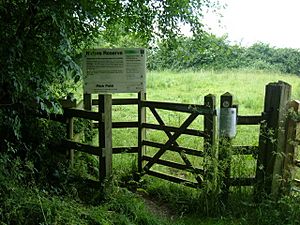Pilch Fields facts for kids
| Site of Special Scientific Interest | |
 |
|
| Area of Search | Buckinghamshire |
|---|---|
| Interest | Biological |
| Area | 11.1 hectares |
| Notification | 1984 |
| Location map | Magic Map |
Pilch Fields is a very special natural area located west of Great Horwood in Buckinghamshire, England. It covers about 11.1 hectares, which is roughly the size of 27 football fields! This amazing place is so important for its wildlife and habitats that it has been officially recognized as a Site of Special Scientific Interest (SSSI).
An SSSI is a protected area in the United Kingdom. It means the land has special plants, animals, or geological features that need to be preserved. Pilch Fields is managed by the Berkshire, Buckinghamshire and Oxfordshire Wildlife Trust, a charity dedicated to protecting wildlife and wild places.
Contents
What Makes Pilch Fields Special?
Pilch Fields is made up of two main areas: Big Pilch and Little Pilch. Both fields are home to a wide variety of natural habitats, making them perfect for many different species of plants and animals.
Diverse Habitats in Big Pilch
Big Pilch is like a patchwork of different natural environments. Here, you can find:
- Wetland areas: These are places where the ground is often wet, like marshes or bogs. They are important for plants and animals that need a lot of water.
- Fen: A type of wetland that gets its water from groundwater, which often makes it rich in minerals. This allows special plants to grow.
- Scrub: Areas with small trees and bushes. These provide shelter and food for many birds and insects.
- A flowing stream: This stream winds its way through the field, providing water for wildlife and creating its own unique habitat.
- Ridge-and-furrow grassland: This is an old type of grassland that looks like waves in the ground. It was created centuries ago by farming methods and now provides different conditions for plants to grow.
Little Pilch and Its Unique Features
The stream from Big Pilch continues into Little Pilch. This area is special because it has:
- Spring-fed fen: This means the fen gets its water from natural springs bubbling up from underground. This constant supply of fresh water helps unique plants thrive.
- Grassland: Open grassy areas that are home to many insects and small mammals.
Incredible Plants and Animals
Pilch Fields is a true haven for biodiversity, meaning it has a huge variety of life.
Amazing Plant Life
More than 200 different types of flowering plants have been recorded at Pilch Fields! This includes many rare and interesting species that thrive in the varied wetland and grassland habitats. The tall, thick hedges around the fields also add to the ecological richness. They act like natural highways and homes for many creatures.
Fascinating Invertebrates
The site is buzzing with invertebrates, which are animals without backbones. You can find:
- Butterflies: Many colorful species flutter among the flowers.
- Moths: Both day-flying and night-flying moths are present.
- Ants: A large variety of ant species live in the soil and among the plants.
Wonderful Birds
Pilch Fields is also a great spot for birdwatching. Some of the birds that call this place home include:
- Turtle doves: These beautiful doves are known for their gentle cooing sound.
- Yellowhammers: Small, bright yellow birds often seen perched on bushes.
- Reed buntings: Birds that prefer wetland areas and can often be found near the stream or fen.
Visiting Pilch Fields
You can visit Pilch Fields! There is access from Pilch Lane. You'll walk through a small field that is part of the nature reserve. Even though this small field is not part of the SSSI itself, it helps you reach the main special area.

